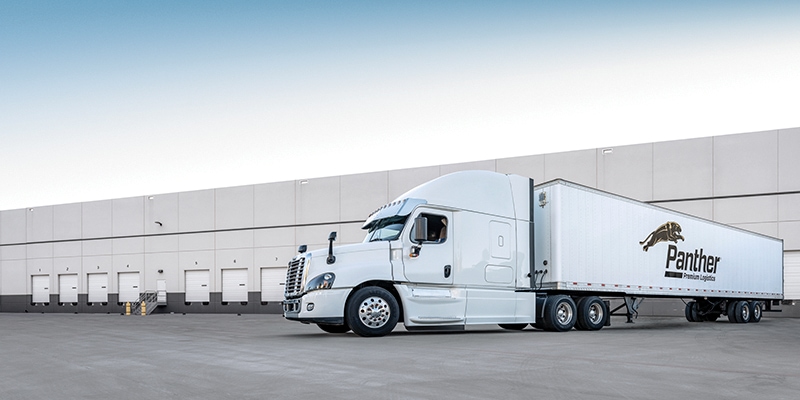9 Quick Tips to Maximize Expedited Shipping

‘Expedite’ does not have to be a bad word in your supply chain. Here’s how to make expedited shipping a strategic strength.
Supply chains are complicated and unpredictable, and shippers inevitably run into problems that disrupt their carefully laid plans.
Among the most important tools that shippers and their partners employ to contend with unplanned challenges is expedited shipping, which provides accelerated delivery speeds for situations when products or materials need to arrive as quickly as possible.
Expedited shipping is a critical component of the supply chain, helping to ensure that shelves are stocked on time and missing materials don’t cause production shutdowns at manufacturing plants.
“It would be great if everything always ran smoothly, and we could just send shipments to dedicated carriers without any issues, but we all know that’s never the case,” says Konrad Warzycha, vice president of solutions for Ohio-based EASE Logistics.
Expedited is a smart solution for dealing with unexpected issues—and it can also play a strategic role in a shipper’s overall transportation plan. Here are nine key tips for effectively navigating the world of expedited shipping.
1. Emphasize Education
It may seem obvious, but shippers who use expedited shipping should understand the service and all of its parameters.
“If expedited shipping is a long-term need for a shipper, I suggest they learn as much about it as possible,” says Liz Wayne, owner and president of Able Transport Solutions in Omaha. A good expedited provider takes the time to educate clients on “how our world works” so they can make the best decisions for their business, she adds. “They may be able to set the table with their customers, so to speak, preparing them for what to expect as well as market changes,” Wayne says.
To start, shippers should have a clear understanding of what “guaranteed” or “expedited” services entail.
“Many people don’t understand how loosely standard LTL servicers often use these terms,” says Chris Bland, Co-CEO, First Call Logistics, based in Indianapolis. “Often those shipments still follow the hub-and-spoke model, which is different from true expedited shipping.
“Since COVID, we’ve seen a drastic increase in customers asking us to rescue shipments trapped at various terminals,” he adds.
 Many people don’t understand how loosely standard LTL servicers often use “expedited” terms. Often those shipments still follow the hub-and-spoke model, which is different from true expedited shipping.
Many people don’t understand how loosely standard LTL servicers often use “expedited” terms. Often those shipments still follow the hub-and-spoke model, which is different from true expedited shipping.
— Chris Bland, Co-CEO, First Call Logistics
2. Ask: Why Expedite? And Why Now?
When considering expedited shipping, it’s useful to ask about the impact of not opting for it.
“Shippers should ask questions such as: Do we need to get the product on the shelf? Do we need to get this part there for production?” Warzycha says.
Shippers in the automotive industry, for example, are highly motivated to avoid an auto-line shutdown. For them, avoiding a production halt is a top priority. “If you get into that type of situation, whatever the cost is to expedite, you have to pay it,” Warzycha explains.
For packaged-goods shippers, however, the case for expedited may not be as clear.
“If you’re losing out on $5,000 in sales and you have to pay $8,000 to get the shipment there, many shippers will choose to hold off on expedited and give up the $5,000 in sales because they don’t want to take a $3,000 loss,” Warzycha says. “It’s important to ask: Why does it need to be expedited? And what are the other options?”
Sometimes a few hours can make a large difference in cost—if you can afford to wait.
“Sometimes you have to pay a higher cost, but you also want to evaluate: Do I need this move now? When is the best time to buy?” Warzycha says. “Should I buy a truck or a trailer carrier tomorrow morning, as opposed to 10 p.m. or midnight tonight? We often suggest doing that because you’re able to buy a lot better.”
The longer transit times associated with standard shipping put additional risk into a supply chain, increasing the threat of an out-of-stock situation or even a plant shutdown.
The speed of expedited shipping mitigates that risk. Often, shippers determine that the longer transit time at a cheaper rate isn’t worth the risk associated with the consequences of a shipment failing to arrive on time. “That can be a tough evaluation to make,” says Eddie Sorg, chief operating officer, asset-light for Arkansas-based ArcBest.
 Don’t simply chase the cheapest transportation option because there are other costs involved: inventory carrying costs, plant shutdowns, and out-of-stock situations.
Don’t simply chase the cheapest transportation option because there are other costs involved: inventory carrying costs, plant shutdowns, and out-of-stock situations.
— Eddie Sorg, COO, ArcBest
3. Don’t “Overbuy”
In order for shippers to avoid purchasing expedited service that they do not actually need, they must understand all their options.
“A good logistics company will be able to quote a number of different service levels and delivery time frames,” Wayne says.
She also advises shippers not to overbuy: “When asked when you—or your customer—need delivery, a reply of ‘ASAP’ could be taken literally and potentially double your transportation costs.”
Similarly, shippers should make sure their service provider is looking for opportunities to match their freight with other freight to save significant costs.
“When you purchase transportation, the price will be determined by a combination of the trailer space/capacity and transit-time constraints,” Wayne says. “With those things in mind, don’t limit the service provider unnecessarily, as it will cause you to overbuy and potentially pay for a service you did not need.”
 When a provider asks when you—or your customer—need delivery, a reply of ‘ASAP’ could be taken literally and potentially double your transportation costs.
When a provider asks when you—or your customer—need delivery, a reply of ‘ASAP’ could be taken literally and potentially double your transportation costs.
— Liz Wayne, Owner, Able Transport Solutions
4. Choose a Strategic Partner
Aligning with logistics providers that can reliably get the job done when something goes wrong is another major factor in successful expedited shipping. The key is to look for a company that serves not as a mere provider, but as a strategic business partner.
“It all has to do with the route guide and picking partners that will not only quote your lanes but be able to service them as well,” Warzycha says. “That’s the most important part of expedited shipping.”
“When selecting a provider, shippers should aim to partner with a company that can be agile with their supply chain and offer insight and strategy during critical moments,” adds Kyle Lane, senior manager of final mile and partial expedite at Chicago-based Coyote Logistics.
“The right provider uses technology and experience to anticipate volatile shipping conditions or fluctuations in demand, which can help shippers avoid expediting whenever possible and choose the most cost-effective option when expedited shipping is necessary,” Lane says.
5. Keep Your Options Open—And Plentiful
In today’s market, it is critical to work with a provider that can offer a variety of solutions. Some providers might excel in one particular area, such as tractor trailers, but “when that capacity is gone, it’s gone; they don’t have other options,” Sorg says. “It’s important to partner with providers that can give you as much capacity as possible to meet all of your needs.”
Many transportation service providers quote costs based only on the information a shipper provides. Shippers should look for a provider that asks the necessary questions to identify cost savings and to offer multiple options.
Similarly, it’s wise to avoid providers that repeatedly suggest expedited shipping as the only solution to challenges rather than providing a range of possible solutions. Sometimes, other alternatives are better, and the right provider can help find the best possible solution.
“That’s how you build strong long-term partnerships,” Sorg says.

ArcBest’s Panther Premium Logistics transports expedited freight on an exclusive-use vehicle, which helps to mitigate risk.
Choose a provider with a dense network of carriers offering multiple equipment types and services. This approach allows shippers to select the best available option based on a shipment’s requirements.
“Prioritize carriers who offer shipment visibility from beginning to end with 24/7 support” Lane says. “This ensures that you can make decisions quickly with information from real-time updates.
“Also be sure to choose a provider that has properly vetted the carriers they work with for up-to-date qualifications, a record of regulatory compliance, and a proven track record of on-time performance,” he adds.
6. Optimize to Expedite the Right Way
In a properly optimized supply chain, expedited shipping is part of the supply chain, but it’s not the dominant part.
“It’s about making sure that shippers use expedited shipping in the places their supply chain really needs it—in the critical components,” Sorg says.
Expedited helps to “bring reliability into the supply chain, so that shippers don’t experience plant shutdowns or disrupt their customers’ operations,” he notes.
Shippers should also understand the critical elements of their supply chain and know which components are clear candidates for expedited shipping when the need arises.
“If shippers have optimized their supply chain, they know where their critical components are and they make sure to have those critical components covered,” Sorg says. “Often there isn’t a big evaluation of transit versus costs because that evaluation has already happened in the supply chain design.”
7. Details and Metrics Matter
Ensuring that expedited aligns with established business metrics—in order to guarantee the best possible mode and carrier selection—is another important factor in the decision to use expedited.
“The most effective shippers often establish cross-functional teams comprising customer service and transportation personnel to avoid conflicting interests that might affect each other’s metrics,” Bland says.
“Additionally, having readily available shipment information minimizes costs and maximizes a shipper’s full available network,” he adds.
“Access to product dimensions, weights, and locations leads to informed decision-making when it comes to carriers, equipment, and mitigating transportation risks.”
It’s also important for shippers to understand that a shipping solution with multiple transit options can be a cost-effective approach to expedited shipping, but it depends on careful attention to details.
For example, if only one pallet out of a six-pallet shipment is truly time-sensitive and the rest can be delivered through standard transit, it’s not necessary to use expedited for the entire shipment.
“You can save costs by only expediting the portion that needs to get there ASAP,” Lane says.
8. Consider All Costs—Not Just Transport
Cost is not typically the top priority when using expedited shipping, but evaluating all the costs associated with expedited shipping is a valuable part of the decision-making process.
“Determine the downstream effects that delays or missed deadlines will have for the freight in question,” Lane says. “If you urgently need a pallet of products, cost will be lower on your list of priorities.
“But if there is any flexibility at all in terms of delivery time, you have more room to weigh your options and see if you can find acceptable transit for a better rate,” he adds.
Inventory carrying costs can “absolutely outweigh” expedited shipping costs, making a decision to use expedited the more affordable option, adds Sorg.
“You don’t want to simply chase the cheapest option from a transportation standpoint because there are other costs involved: inventory carrying costs, plant shutdowns, out-of-stock situations.
“Having a relationship with an expedited partner who can talk you through your supply chain, determine what’s critical and then introduce a solution that makes the supply chain more resilient and more robust to different capacity environments will help you win in the long run,” Sorg says.

Effective expedited shipping means urgent deliveries get to their destination on time. To that end, shippers should work with expedited providers offering access to a range of transportation options.
Emphasizing cost and choosing the cheapest option for expedited shipping carries particular risks because it can put the shipper in a major bind if the provider is unable to provide the necessary service.
“You have to ask: Who will service the lane?” Warzycha says. “Trust is huge when it comes to expediting.”
Keeping options open when evaluating cost and service is also important for shippers. For instance, air transport services “can provide uniquely effective service offerings for door-to-door transport,” Lane notes.
“Remember, the price you pay now for niche services like these is in the interest of avoiding potentially far greater costs in the future by keeping your business moving,” he says.
9. Expedite is not a Dirty Word
Expedited shipping can fill shippers with dread, but that doesn’t have to be the case.
“Expedited has a negative connotation. It implies that something went wrong in your supply chain: the routing guide broke down, there was a breakdown in transit,” Warzycha says. “All shippers would like to avoid expedited shipments because they are stressful, and they create a whirlwind where you have to drop everything else to recover the shipment. But if you have the right partners in place — if you have a reliable, trustworthy, consistent carrier that you can use for transport — it really becomes a simple process.”
